
Trotec says the combination of carbon dioxide and fiber laser sources on its Speedy Flexx laser machines means the application possibilities are “almost unlimited”
Walking around the halls of sign exhibitions, there is always one type of machine that tends to catch my eye—laser cutters. While much of the attention may be on wide-format printers and their many wonderful features, the technology behind the workface of a laser cutter is incredible.
Perhaps it is a childhood spent playing video games that has done this to me, but there is something about the word ‘laser’ that immediately grabs my attention and screams ‘futuristic’. That said, this type of technology has been a successful part of some sign-making operations for some time already.
With this in mind, here we look at some of the latest technologies on the market and examine how it can help sign companies achieve a higher level of output in their various applications and work.
Value for money
One of the leading names in this market sector is Trotec, which is able to provide a portfolio of laser engraving, cutting, and marking systems, alongside a range of engraving and cutting materials. James Hutton, marketing executive at Trotec, says it is critical for sign-making companies to invest in quality laser cutting kit in order to achieve the best possible output.
“There are plenty of low cost laser systems available to businesses who are looking to add to their manufacturing capabilities,” Hutton says, adding: “While price is always an important consideration, value for money has to be the real consideration when making a purchase.

While price is always an important consideration, value for money has to be the real consideration when making a purchase”
“Production speed, reliability, quality, and support are all aspects where a Trotec machine will make a huge difference which is why we have invested in our showrooms, we want people to come and see for themselves.”
Hutton goes on to pick out the main advantages of opting for laser cutting kit as opposed to other methods, focusing on three key points for sign-makers to consider.
“Laser systems are hugely versatile in that you can process a huge range of materials without the constant changing of tooling,” Hutton says, adding: “One minute the laser can be processing 8mm acrylic and then paper or card the next and all that requires changing are some settings in the printer driver.
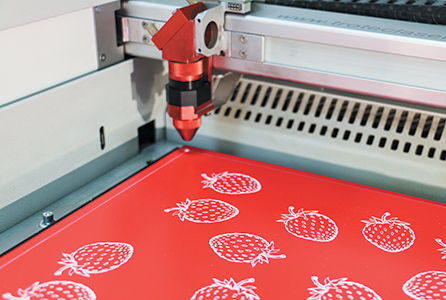
Speedy Flexx laser machines from Trotec feature both carbon dioxide and fiber laser sources
“A laser doesn’t require the substrate to be held down to the bed as, unlike most other processes, there are no forces on the material which would cause it to move. The small cutting width generated by a laser is another key factor as inlaying and model making can be achieved without the need to offset the drawing.
“Also, a laser can engrave or mark substrates far faster than can be achieved with a mechanical process. It is also clean as a laser vaporises the substrate rather than generating swarf.”
With this in mind, Hutton draws attention to the latest offerings from Trotec in the form of Speedy flexx laser machines, which feature both carbon dioxide and fiber laser sources.
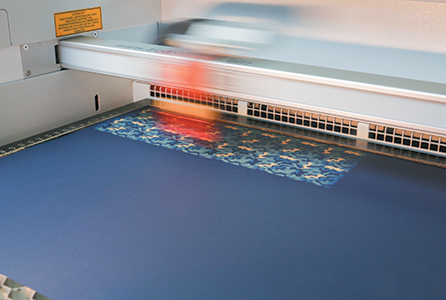
The CO2 laser source on the Trotec Speedy Flexx is suited more for engraving and cutting plastics, acrylic, and wood, while the fibre laser can be used for marking metals
Hutton says: “Thanks to this combination the application possibilities are almost unlimited, with the CO2 laser source ideally suited for engraving and cutting plastics, acrylic, wood, and many other materials while the fiber laser is perfect for marking metals.”
Spend money, make money
Also well equipped to provide advice and solutions in this market is Epilog Laser, which offers CO2 and fiber laser engraving, cutting, and marking systems. Mike Dean, vice-president of sales and marketing, says that while laser systems can be incredibly precise and exceptionally versatile, they are not all created equal.
Dean explains: “While inferior lasers with a lower price tag may be appealing at first, they come with a list of drawbacks including lack of instruction, complicated proprietary design software, lack of technical support, and short laser life.
“Investing in a high-quality machine is well worth the extra money up front.
Working with an established vendor like Epilog ensures you have a high-quality, long-lasting laser tube, a standard warranty in place, a dedicated support team to ship parts and minimise any downtime, comprehensive manuals covering everything from set up to maintenance, and much more.”
Focusing on the debate of laser versus other cutting and engraving techniques, Dean says while traditional methods “are very much alive and well” in the sign-making industry, laser kit does have a number of standout advantages.
Dean says: “Laser cutters and engravers offer exceptionally detailed and accurate results in minimal time. Whether you’re cutting dimensional letters, engraving a logo, or creating custom inlays, lasers offer incredible detail, repeatability, and precision.
“Additionally, lasers work with a variety of materials. One system allows you to cut a multitude of substrates including acrylic, plastic, wood, cork, rubber, and much more. And while they cannot cut through harder materials like glass, slate, and metal, a CO2 system can easily mark these popular substrates.”
Machines available from Epilog include the Fusion M2 40, the latest addition to the firm’s laser line-up. Featuring what Dean describes as a “generous” work area of 40 x 28” and a choice of wattage configurations, the model is available with a CO2 laser source, a fiber laser source, or both.
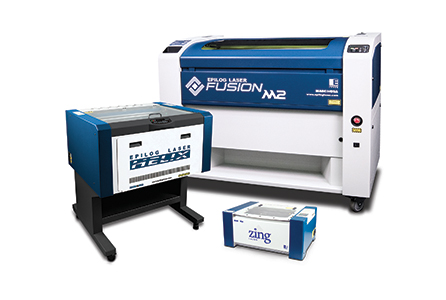
The Fusion M2 40 is the latest addition to Epilog Laser’s portfolio. Users benefit from a work area of 101.6 x 71.1cm
Dean says: “Fiber lasers are more specialised and ideally suited for marking bare metals and engineered plastics; however, depending on customer demand, some sign manufacturers may be interested in having both types of laser sources.”
Another innovation on the M2 Laser series is Epilog’s Epilog’s E View Camera Module. Camera recognition systems on lasers are becoming more popular as they give laser operators the ability to cut pre-printed graphics on nearly any substrate with greater precision.
Dean says Epilog’s E View makes cutting printed graphics “incredibly easy” and produces “exceptionally precise results” from anywhere on the table. He adds: “There’s no need to line up your graphics to the top left corner of the machine, or even to align it to the x and y-axes. Users simply add registration marks to their graphic
and the cameras detect exactly where to cut.
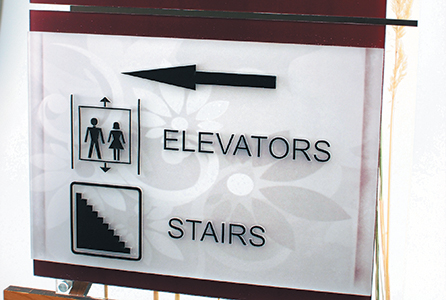
Epilog Laser says its laser cutting and engraving machinery can be used to create a plethora of signage applications, including wayfinding signage
“What really sets Epilog’s E View apart is its three-camera design. Other single-view camera systems must be programmed manually to locate registration marks, but the E View system ‘sees’ the registration marks, locates their precise position, and feeds your exact project layout back to your computer screen before cutting.”
Analysing options
There are a number of other leading manufacturers and suppliers in this sector that can also help sign-makers in their quest to enhance cutting and engraving production.
ATA Engineering can offer its new ATACAM range of CNC laser cutters, which are available in models for both metallic and non-metallic materials. Each of these machines is kitted out with carbon dioxide laser tubes, which ATA says can be used for cutting metal sheet such as carbon steel and stainless steel, as well as non-metallic materials including acrylic, die bond, MDF, and plywood.
The ALM1390 model can be used for both metallic and non-metallic cutting. This machine boasts a cutting area of 1,300 x 900m and is able to cut at a resolution of within 0.05mm. The ALM1390 can be used in combination with Corel Draw, Auto CAD, and Photoshop software, and supports the BML, HPGL, PLT, DST, and AI formats.
O Factoid: In 1960, Theodore H. Maiman used research from Charles Hard Townes and Arthur Leonard Schawlow to build the world’s first laser at Hughes Research Laboratories in Malibu, California. O
Sister machine, the AL1390, is designed for the cutting of non-metallic materials only. Featuring a cutting area of 1,300 x 900 x 500mm, this model can also cut a resolution of within 0.05mm and has a table that can have its height adjusted to the users’ preference.
Elsewhere, HPC Laser has a number of solutions available for both cutting and engraving applications. The company’s portfolio ranges from desktop models through to top-end machines capable of taking on larger work.
Products that may be of interest to those in the sign-making sector include the top-end LS1325 model for mixed metal and no-metal cutting. The 2412 mixed metal hybrid flatbed laser cutter has a work area of 1,300 x 2,550mm and can cut at speeds of up to 200mm/s. Supplied with professional software, the machine is able to work with Corel Draw, 2D Deign, Art cut, and Auto CAD, and has a resetting position accuracy of 0.01mm.
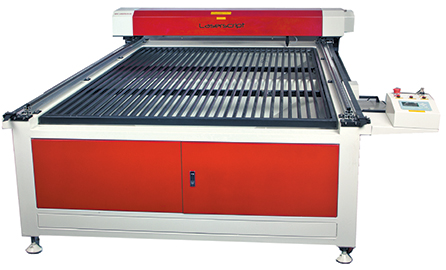
The LS2515 Pro is a flatbed laser cutter from HPC Laser that has a top cutting speed of
600mm/s
On its website, HPC Laser says: “The 2412 mixed metal hybrid flatbed laser cutter allows large sheets of material to be cut at fast speeds with options of a high power 150/180w/220w CO2 long life (10,000hr) laser tube.
“The LS2412 has hard-wearing stainless steel bearings, and linear guide rails for precision, accuracy, and repeatability. It is able to cut 1.2mm stainless steel, 2mm mild steel, acrylic, plywood, MDF, fabrics, rubber, plus many more materials.”
Also available from HPC Laser is the LS2515 Pro, a flatbed laser cutter that boasts a work area of 2,500 x 1,500mm, a maximum cutting depth of 20mm on acrylic, and a top cutting speed of 600mm/s. CE approved and PAT tested—as are all machines from HPC Laser—the LS2515 Pro has a resetting position accuracy of 0.01mm and comes with an option of a 150/180w/220w CO2 long life laser tube.
With plenty of solutions on offer in this sector of the market, sign-making firms are not short of options when it comes to laser cutting and engraving machinery. However, the message from manufacturers in this area seems relatively simple, but impactful: invest in quality to get quality results. While the initial purchase may set you back a fair bit, the results in the long-run will be both rewarding and plentiful.
Your text here...